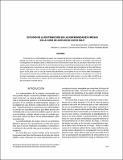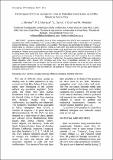Buscar
Mostrando ítems 1-10 de 25
First Report of Citrus Blight in Costa Rica
(2005-01)
Citrus blight (CB), causing a chronic decline of citrus, has been an important disease in Florida for over 100 years. CB was first reported in Brazil in the 1980s and is now responsible for the removal of nearly 10% of the ...
First Report of Xylella fastidiosa in Avocado in Costa Rica
(2008-01)
Since the late 1990s, chlorotic mottling, marginal scorch, deformation of leaves, defoliation, shortening of internodes, and branch dieback have been observed in avocado trees (Persea americana Mill.) in Costa Rica. The ...
‘Candidatus Phytoplasma costaricanum’ a novel phytoplasma associated with an emerging disease in soybean (Glycine max).
(2011-12)
A novel phytoplasma, designated strain SoyST1c1, associated with a newly emerging disease in soybean (Glycine max), known as soybean stunt (SoyST), was found in 2002 in a soybean plantation in Alajuela Province, Costa Rica. ...
Identification and distribution of melon infecting viruses and their vectors in two provinces of Costa Rica
(1993)
Papaya ringspot potyvirus (PRSV), watermelon mosaic 2 potyvirus (WMV-2), cucumber mosaic cucumovirus (CMV) and zucchini yellow mosaic potyvirus (ZYMV), singly or in mixed infections, were identified by ELISA in melon ...
Guazuma ulmifolia (Sterculiaceae), a new natural host of 16SrXV phytoplasma in Costa Rica
Guazuma ulmifolia (Sterculiaceae), un nuevo hospedero natural de fitoplasmas del grupo 16SrXV en Costa Rica
(2011-04)
Guacimo trees (Guazuma ulmifolia, Sterculiaceae) showing witches’ broom symptoms (GWB), small leaves, short internodes, stunting and no flower and fruit production were observed on side roads and fences in different areas ...
Estudio de la distribución de las enfermedades virosas de la caña de azúcar en Costa Rica
(2006)
El estudio de las enfermedades de origen viral requiere de técnicas inmunológicas de alta precisión y confiabilidad. Haciendo uso de estas herramientas y con el apoyo del Ministerio de Ciencia y Tecnología y del Centro de ...
First report of Xylella fastidiosa infecting coffee in Costa Rica
(2001-09)
In 1995, severe symptoms were observed on ‘Caturra’ and ‘Catuaí’ coffee (Coffea arabica L.) varieties in farms in the southern part of the Central Valley in Costa Rica. Symptoms were reduced leaf size, malformation of ...
First Report of Citrus variegation virus in Palestine Sweet Lime, as Coffee Shade in Costa Rica
(2011)
Symptoms resembling those of Citrus variegation virus (CVV) were observed in old Palestine sweet lime trees (Citrus limettioides Tan.) used as coffee shade in the Central Valley in Costa Rica. The symptoms include leaf ...
Chayote mosaic, a new disease in Sechium edule caused by a tymovirus
(1997-04)
A sap-transmissible virus was isolated from chayote (Sechium edule) in Costa Rica. Infected plants showed chlorotic spots and rings, and blotchy mosaics, which often coalesced to give a complete mosaic and leaf deformation. ...
Infección de la orquídea terrestre Phaius tankervillae (Orchidaceae) con el cymbidium mosaic potexvirus (CymMV) en Costa Rica
(1999)
En 1996, en un pequeño vívero comercial en la zona oeste del Valle Central de Costa Rica se observaron plantas de la orquídea terrestres Phaius tankervilliae que mostraban síntomas foliares de leves a severos de un estriado ...






